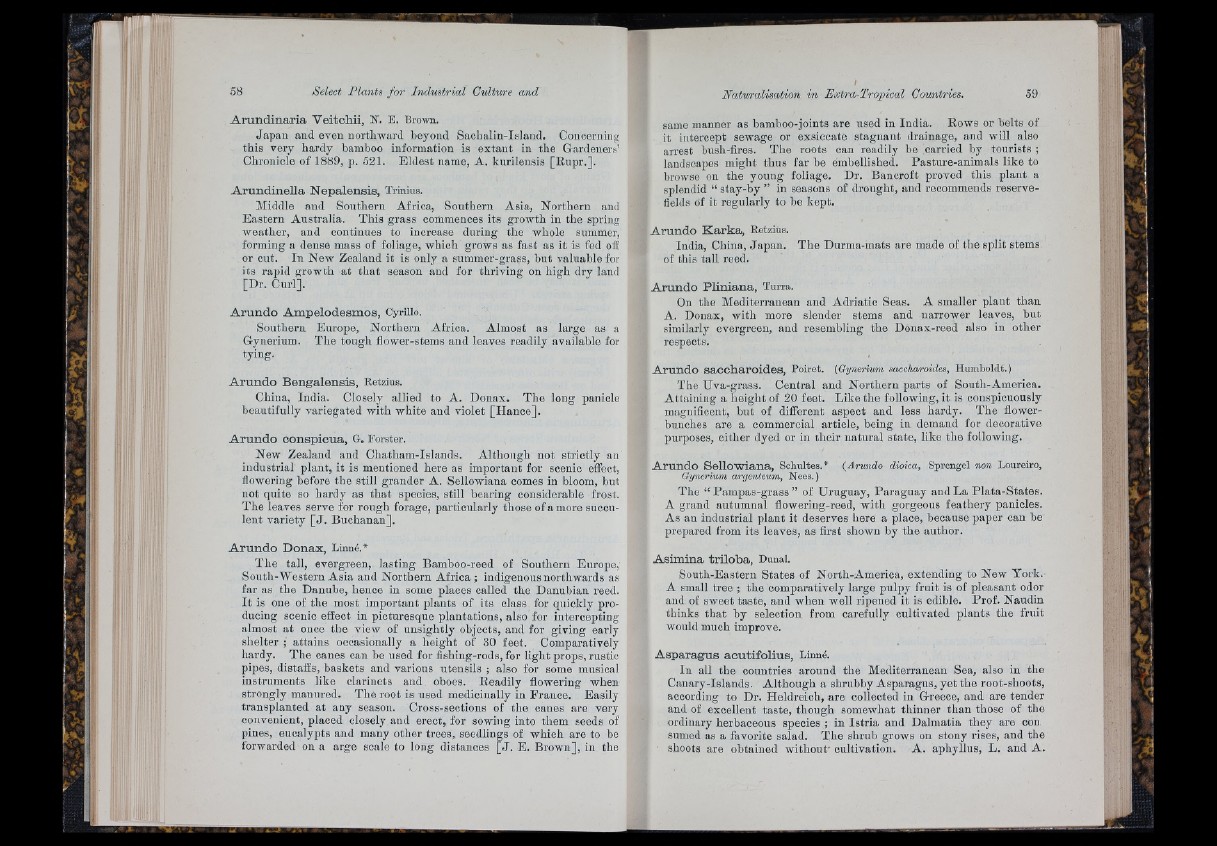
58
A ru n d in a r ia V e itch ii, N. E. Brown.
Japan and even northward beyond Sachalin-Island. Concerning
this very hardy bamboo information is extant in the Gardeners’
Chronicle of 1889, p. 521. Eldest name, A. kurilensis [Rupr.].
A ru n d in e lla N e p a le n s is , Trinins.
Middle and Southern Africa, Southern Asia, Northern and
Eastern Australia. This grass commences its growth in the spring
weather, and continues to increase during the whole summer,
forming a dense mass of foliage, which grows as fast as it is fed off
or cut. In New Zealand it is only a summer-grass, but valuable for
its rapid growth at that season aud for thriving on high dry land
[Dr. Curl].
A ru n d o A m p e lo d e sm o s , Cyrillo.
Southern Europe, Northern Africa. Almost as large as a
Gynerium. The tough fiower-stems and leaves readily available for
tying-
A ru n d o Beng-alensis, Retzius.
China, India. Closely allied to A. Donax. The long panicle
beautifully variegated with white and violet [Hance].
A ru n d o c o n sp ic u a , G. Forster.
New Zealand and Chatham-Islands. Although not strictly an
industrial plant, it is mentioned here as important for scenic effect,
flowering before the still grander A. Sellowiana comes in bloom, but
not quite so hardy as th a t species, still bearing considerable frost.
The leaves serve for rough forage, particularly those of a more succulent
variety [ J . Buchanan].
A ru n d o D o n ax , Linné.*
The tall, evergreen, lasting Bamboo-reed of Southern Europe,
South-Western Asia and Northern Africa ; indigenous northwards as
far as the Danube, hence in some places called the Danubian reed.
I t is one of the most important plants of its class for quickly producing
scenic effect in picturesque plantations, also for intercepting
almost a t once the view of unsightly objects, and for giving early
shelter • attains oecasionally a height of 30 feet. Comparatively
hardy. The canes can he used for fishing-rods, for light props, rustic
pipes, distaffs, baskets and various utensils ; also for some musical
instruments like clarinets and oboes. Readily flowering when
strongly manured. The root is used medicinally in France. Easily
transplanted at any season. Cross-sections of the canes are very
convenient, placed closely and erect, for sowing into them seeds of
pines, eucalypts and many other trees, seedlings of which are to be
forwarded on a arge scale to long distances [ J . E. Brown], in the
same manner as bamboo-joints are used in India. Rows or belts of
it intercept sewage or exsiccate stagnant drainage, and will also
arrest bush-fires. The roots can readily be carried by tourists ;
landscapes might thus far be embellished. Pasture-animals like to
browse on the young foliage. Dr. Bancroft proved this plant a
splendid “ stay-by ” in seasons of drought, and recommends reserve-
flelds of it regularly to be kept.
A ru n d o K a rk a , Retzius.
India, China, Japan. The Durma-mats are made of the split stems
of this tall reed.
A ru n d o P lin ia n a , Turra.
On the Mediterranean and Adriatic Seas. A smaller plant than
A. Donax, with more slender stems and narrower leaves, but
similarly evergreen, and resembling the Donax-reed also in other
respects.
A ru n d o s a c o h a ro id e s , Poiret. (Gynerium saccharoides, Humboldt.)
The Uva-grass. Central and Northern parts of South-America.
Attaining a height of 20 feet. Like the following, it is conspicuously
magnificent, but of different aspect and less hardy. The flower-
bnnches are a commercial article, being in demand for decorative
purposes, either dyed or in their natural state, like the following.
A ru n d o S e llow ian a , Schultes.* {Arundo dioica, Sprengel non Loureiro,
Gynerium argenteum, Nees.)
The “ Pampas-grass” of Uruguay, Paraguay and La Plata-States.
A grand autumnal flowering-reed, with gorgeous feathery panicles.
As an industrial plant it deserves here a place, because paper can he
prepared from its leaves, as first shown by the author.
A s im in a tr ilo b a , Dunal.
South-Eastern States of North-America, extending to New York.
A small tree ; the comparatively large pulpy fruit is of pleasant odor
and of sweet taste, and when well ripened it is edible. Prof. Naudin
thinks th a t by selection from carefully cultivated plants the fruit
would much improve.
A sp a ra g u s a c u tifo liu s , Linné.
In all the countries around the Mediterranean Sea, also in the
Canary-Islands. Although a shrubby A sparagus, yet the root-shoots,
according to Dr. Heldreich, are collected in Greece, and are tender
and of excellent taste, though somewhat thinner than those of the
ordinary herbaceous species ; in Istria and Dalmatia they are eon
sumed as a favorite salad. The shrub grows on stony rises, and the
shoots are obtained without' cultivation. A. aphyllus, L. and A.
V 'l l
i::/
i;
A":